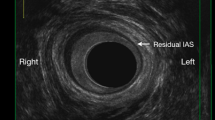Abstract
Background
Internal anal sphincter achalasia (IASA) is a condition with presentation similar to Hirschsprung’s disease (HD), but with the presence of ganglion cells on rectal suction biopsy (RSB). The diagnosis is made on anorectal manometry (ARM) by the absence of the rectosphincteric reflex on rectal balloon inflation. Internal sphincter myectomy (ISM) is the treatment of choice for patients with IASA. Recently, botulinum toxin has been used to treat IASA patients. The purpose of this study was to assess the long-term bowel function in patients with IASA following ISM.
Methods
The medical records of 24 patients with IASA managed by ISM during 1993–2005 were examined. There were 18 boys and 6 girls, aged 2–12 years. All patients presented with intractable constipation with or without soiling. The diagnosis was made by the demonstration of the absence of the rectosphincteric reflex on ARM. HD was excluded by the presence of ganglion cells and normal acetylcholinesterase activity in RSB. Patients were followed 4–14 years later.
Results
Fifteen (62.5%) patients at the time of follow-up had regular bowel motions without the use of laxatives. Six (25%) patients had regular bowel motions, but remained on small doses of laxatives. Two (8.3%) patients who suffered from constipation and soiling required twice weekly enemas to remain clean. One (4.2%) patient required resection of dilated rectosigmoid colon 3 years after myectomy, remains on laxatives, but has normal bowel control. No patients had faecal incontinence following ISM.
Conclusion
This long-term follow-up study shows that the vast majority of IASA patients have normal bowel control following ISM.
Similar content being viewed by others
References
Hirawaka H, Kobayashi H, O’Briain DS et al (1995) Absence of NADPH-diaphorase activity in internal anal sphincter (IAS) achalasia. J Pediatr Gastroenterol Nutr 20(1):54–58
Oue T, Puri P (1999) Altered intramuscular innervations and synapse formation in internal sphincter achalasia. Pediatr Surg Int 15:192–194
Piotrowska AP, Solari V, Puri P (2003) Distribution of interstitial calls of Cajal in the internal Anal sphincter of patients with internal anal sphincter achalasia and Hirschsprung’s disease. Arch Pathol Lab Med 127
Tumbull JK, Vanner SJ, Bumstein M (1997) The colon. In: Shaffer EA, Thomas ABR (eds) First principles of gastroenterology: the basis of disease and approach, 3rd edn. Astra Pharmaceuticals Canada Ltd, Canada, pp 364–370
DeCaluwe D, Yoneda A, Akl U et al (2001) Internal anal sphincter achalasia: outcome after internal sphincter myectomy. J Pediatr Surg 36(5):736–738
Holshneider AM, Kunst M (2008) Anal sphincter achalasia and ultrashort Hirschsprung’s disease. In: Holschneider AM, Puri P (eds) Hirschsprung’s disease and allied disorders, 3rd edn. Springer, New York, pp 316–318
Heikkinen M, Lindahl H, Rintala RJ (2005) Long-term outcome after internal sphincter myectomy for internal sphincter achalasia. Pediatr Surg Int 21:84–87
Messineo A, Codrich D, Monai M, Martellosi S (2001) Ventura A: the treatment of internal anal sphincter achalasia with botulinum toxin. Pediatr Surg Int 17:521–523
Irani K, Rodriguez L, Doody DP et al (2008) Botulinum toxin for the treatment of chronic constipation in children with internal anal sphincter dysfunction. Pediatr Surg Int 24:779–783
Foroutan HR, Hosseini SM, Bahador A et al (2008) Role of rectal biopsy in predicting response to intrasphincteric botulinum toxin injection for obstructive symptoms after a pullthrough operation. Indian J Gastroenterol 27(3):99–102
Author information
Authors and Affiliations
Corresponding author
Rights and permissions
About this article
Cite this article
Doodnath, R., Puri, P. Long-term outcome of internal sphincter myectomy in patients with internal anal sphincter achalasia. Pediatr Surg Int 25, 869–871 (2009). https://doi.org/10.1007/s00383-009-2436-5
Published:
Issue Date:
DOI: https://doi.org/10.1007/s00383-009-2436-5




